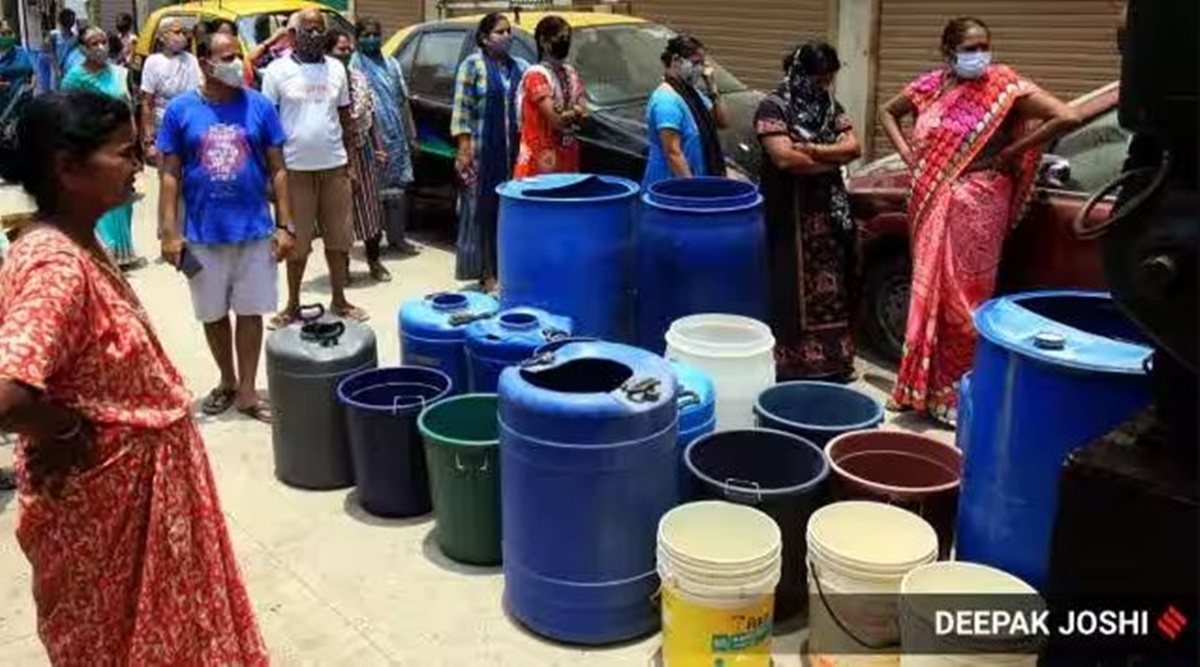Starting from a treatment plant to underground reservoirs and then a Delhiite’s home, water makes its way through a city pipeline network that is over 15,000 km long. Some of it, however, goes missing – it may be lost in transit, the pipeline may have sprung a leak, or it is being pilfered.
According to data from the Delhi Jal Board (DJB), on some days and from some water treatment plants, this water that is ‘unaccounted’ for is a significant amount, even before it reaches the stage of supply to consumers.

From the Chandrawal water treatment plant, for instance, on the last two days of August, the ‘unaccounted’ flow was as high as over 60 MGD — over 60% of the 99 MGD of water that the plant produced on these days. This plant supplies water to parts of Central and North Delhi.
 In a communication issued in June, the CMO had said the DJB’s assessment points to a “lack of proper records regarding available water”.
In a communication issued in June, the CMO had said the DJB’s assessment points to a “lack of proper records regarding available water”.
From August 1 to 31, the average ‘unaccounted flow’ from Chandrawal was 20.9 MGD, and it was zero on only six days of the month, DJB data shows. This is several times what the Economic Survey of Delhi pegs as the norm per capita per day for water supply — 60 gallons per capita per day.
This data is being drawn via a network of 2,691 flowmeters, devices that measure the flow of water. A control room at the DJB headquarters, set up in 2019, monitors this data. These meters calculate water supplied and distributed from water treatment plants to underground reservoirs only.
Unaccounted water from the Wazirabad and Nangloi water treatment plants is also significant.
“Production and distribution from 9 WTPs (water treatment plants) are being monitored in real-time from the control room. Close to 870 MGD of water is produced from these plants. A total of 2,715 flowmeters were to be installed in the first phase, of which 2,691 were in place. The project cost for all packages was Rs 224 crore. Another 1,537 are to be placed in phase 2. The Chief Minister has given a deadline of December 2023 to install all flow meters and to be able to have every drop of water audited,” said DJB Vice-Chairman Somnath Bharti.
What does the DJB learn from the data and how is it used?
According to Bharti, pilferage and leakages can be identified through flow meters. “If we succeed in plugging all such points, we will have enough water for every Delhiite. Water from the WTP goes to a primary UGR (underground reservoir) and then a secondary UGR. Major (instances of) pilferage are found between the primary and secondary UGR. We get a daily report on the data, and the information (from the control room) goes to the additional chief engineer (maintenance) to look into.”
“We can also figure out the deficit for a particular area and learn how much additional water we need to supply,” he added.
All flowmeters would have to be placed for a clearer picture.
“From the rising mains (which carry water from the WTP) to inlets of the primary UGRs, 108 flowmeters are yet to be installed. From the outlet of the primary UGR to the secondary UGR inlets, 1,429 flowmeters are to be installed. The Dwarka and Nangloi WTPs are 100% covered from the rising main to the secondary inlet. It (this system) helps to see if the water that left the WTP has reached the secondary UGR or not,” Bharti said.
A DJB official associated with the functioning of the control room explained further: “If we are producing ‘x’ amount and ‘y’ amount is being utilised, the balance is not traced. That could be in the form of transmission losses, water theft, leakages, or we may not have measured in a particular area. This is unaccounted flow. Distribution of water is calculated on the basis of water meters with the end users.”
Most Read 1Chandrayaan-3 mission: Dawn breaks on Moon, all eyes on lander, rover to wake up 2As Indo-Canadian relations sour, anxiety grips Indian students, residents who wish to settle in Canada 3Karan Johar says Sanjay Leela Bhansali did not call him after Rocky Aur Rani: ‘He’s never called me but…’ 4Gadar 2 box office collection day 40: Hit by Shah Rukh Khan’s Jawan onslaught, Sunny Deol movie ends BO run with Rs 45 lakh earning 5Shubh’s tour in India cancelled: Why is the Canada-based singer facing the music?
“After the secondary UGR, there are so many branches that measuring becomes difficult… In some cases, flowmeters may not have been installed… There could also be instances of the flowmeter becoming defunct… If the flowmeter is not working, it stops blinking in the control room, so then we know there’s a fault. A fault report is made every 15 days and the operations and maintenance team attends to it,” the official said.
In a communication issued in June, the CMO had said the DJB’s assessment points to a “lack of proper records regarding available water”.
Also ReadStray dogs released after G20 ‘missing’ in Delhi, rescuers join hands to …Wife refused to keep karwa chauth fast, didn’t acknowledge husband: HC up…Atishi makes ‘surprise inspection’ of MCD school, orders action against t…How a letter from an organisation promoting Urdu culture led Delhi Police…
“Although water is supplied to different areas, it is not being recorded in the DJB’s audit system. Over the past few decades, the main water lines that used to serve these areas have been tapped and redistributed to different locations. Consequently, many areas receive water at low pressure or no water at all,” it said.
Get more updates on Delhi News Today. Also get Latest News Updates on G20 India Summit at The Indian Express.
© The Indian Express (P) Ltd


